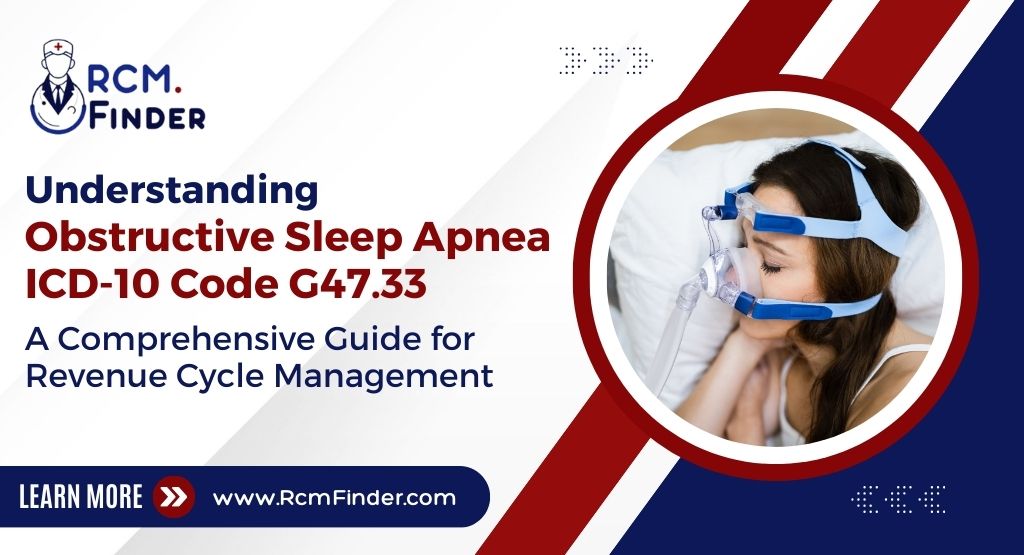
Obstructive Sleep Apnea ICD 10 Code Guide For Healthcare Providers
Table of Contents
Millions of people worldwide suffer from OSA, which is also known as obstructive sleep apnea. The purpose of this article is to provide healthcare providers with information on Obstructive Sleep Apnea ICD 10 Code G47.33, which is particularly important for revenue cycle managers. Using appropriate coding and billing practices can help healthcare organizations recognize, treat, and reimburse patients efficiently.
Obstructive Sleep Apnea: What is it?
Symptoms and definitions
It is a condition in which people with a sleep disorder start and stop breathing repeatedly during their sleep. According to an expert it is possible for these disturbances to last for seconds to minutes and to be experienced several times during the course of an hour. Here are some common symptoms:
- Loud Snoring: Often reported by bed partners, loud snoring is an OSA symptom.
- Gasping or Choking During Sleep: Sleepers may wake up gasping for air.
- Morning Headaches: Sleep disruption can cause headaches upon waking.
- Excessive Daytime Sleepiness: Poor sleep quality can lead to fatigue or sleepiness during the daytime.
Risk factors and causes
In OSA, it has been observed that the throat muscles relax too much, which causes blocking of the airway. Among the factors associated with Obstructive Sleep Apnea (OSA) are:
- Obesity: Being overweight can narrow your airways.
- Age: Risk increases with age, especially for those over 40.
- Family history: Sleep apnea is more likely to occur if you have a family member with it.
- Smoking: Smoking is one of the reasons for swelling and extra fluid in the upper airways.
- Alcohol Consumption: Alcohol relaxes the muscles of the throat, increasing the chances of airway obstruction.
Prevalence and impact
According to a study by the American Academy of Sleep Medicine, approximately 25 million Americans suffer from sleep apnea. Which also indicated that 80% of moderate to severe cases go undiagnosed, leading towards serious health complications.
Table 1: Prevalence of OSA by Age and Gender
| Age Group | Prevalence (%) | Gender Distribution (Male/Female) |
|---|---|---|
| 30-39 | 4% | 3:1 |
| 40-49 | 9% | 4:1 |
| 50-59 | 22% | 5:1 |
| 60+ | 24% | 2:1 |
The Importance of ICD-10 Code G47.33
What is ICD-10?
The International Classification of Diseases, 10th Revision (ICD-10), is a standardized coding system used by healthcare providers to document diagnoses and procedures. The code G47.33 specifically denotes Obstructive Sleep Apnea and plays a vital role in patient care and billing.
Significance of G47.33
- Accurate Diagnosis: Using G47.33 ensures that healthcare providers can correctly identify and diagnose OSA.
- Effective Treatment Planning: Proper coding facilitates tailored treatment strategies for patients.
- Streamlined Reimbursement: Insurers rely on accurate coding for reimbursement processes, making it essential for healthcare facilities to code correctly.
Financial Implications of OSA
The financial burden of untreated OSA is significant. According to a study published in the American Journal of Respiratory and Critical Care Medicine, untreated OSA costs the U.S. economy approximately $149 billion annually due to lost productivity, healthcare expenses, and motor vehicle accidents.
Impact on Comorbidities
OSA is associated with several comorbid conditions, including:
- Cardiovascular Disease: Individuals with OSA are more likely to develop hypertension, heart disease, and stroke.
- Diabetes: OSA can exacerbate insulin resistance and glucose intolerance.
- Depression and Anxiety: Sleep disturbances can contribute to mental health issues.
Other Relevant ICD-10 Codes for Sleep Apnea
In addition to G47.33, there are other ICD-10 codes related to sleep apnea that healthcare providers should be aware of:
- G47.30: Unspecified Sleep Apnea
- G47.31: Primary Central Sleep Apnea
- G47.32: High Altitude Periodic Breathing
- G47.34: Idiopathic Nonobstructive Alveolar Hypoventilation
- G47.35: Congenital Central Alveolar Hypoventilation
- G47.37: Central Sleep Apnea Elsewhere
- G47.39: Other Sleep Apnea
Table 2: Summary of Related ICD-10 Codes
| ICD-10 Code | Description |
|---|---|
| G47.30 | Unspecified Sleep Apnea |
| G47.31 | Primary Central Sleep Apnea |
| G47.32 | High Altitude Periodic Breathing |
| G47.33 | Obstructive Sleep Apnea (OSA) |
| G47.34 | Idiopathic Nonobstructive Alveolar Hypoventilation |
| G47.35 | Congenital Central Alveolar Hypoventilation |
| G47.37 | Central Sleep Apnea Elsewhere |
| G47.39 | Other Sleep Apnea |
Clinical Overview of OSA Management
Diagnosis
Diagnosing OSA typically involves:
- Thorough Medical History Review: A detailed assessment of symptoms and family history.
- Physical Examinations: Assessment of the airway and throat.
- Polysomnography (Sleep Study): A comprehensive test that records brain waves, blood oxygen levels, heart rate, and breathing, along with eye and leg movements during sleep.
The American Academy of Sleep Medicine recommends home sleep apnea testing for patients with a high pre-test probability of OSA.
Treatment Options
Treatment for OSA varies based on severity and may include:
Lifestyle Modifications:
- Weight Loss: Even a modest reduction in weight can significantly improve symptoms.
- Sleep Positioning: Encouraging side sleeping can help alleviate symptoms.
- Avoiding Alcohol and Sedatives: These substances can relax throat muscles and worsen symptoms.
Medical Devices:
Continuous Positive Airway Pressure (CPAP): The most common treatment, which involves wearing a mask that delivers air pressure to keep the airway open during sleep.
Effectiveness: Research indicates that CPAP therapy can reduce OSA events by 50-90%, significantly improving sleep quality.
Surgical Interventions:
- In severe cases, surgery may be necessary to remove excess tissue from the throat or to reposition anatomical structures that contribute to airway obstruction.
- Uvulopalatopharyngoplasty (UPPP) is one common surgical procedure performed to remove tissue from the throat.
Follow-Up and Monitoring
Continuous monitoring and follow-up are essential to evaluate the effectiveness of treatment. Regular follow-up visits can help assess symptom improvement, compliance with treatment, and any necessary adjustments.
Transitioning from ICD-9 to ICD-10
The transition from ICD-9 to ICD-10 brought significant changes to coding practices. Healthcare providers faced challenges during this shift, making ongoing training and education essential to ensure accuracy in coding and billing.
Key Differences Between ICD-9 and ICD-10
- Increased Specificity: ICD-10 allows for much greater specificity in coding, which is crucial for proper diagnosis and treatment.
- Expanded Codes: ICD-10 includes over 68,000 codes, compared to about 14,000 in ICD-9.
- Improved Structure: The structure of ICD-10 allows for easier categorization and retrieval of codes.
Impact on Revenue Cycle Management
The transition to ICD-10 has led to increased complexity in coding and billing processes, which can impact revenue cycle management. Healthcare providers must invest in training and resources to ensure compliance and accuracy.
Preparing for ICD-11
With the upcoming transition to ICD-11, healthcare professionals should stay informed about changes that will enhance coding specificity for sleep apnea diagnoses. This preparation is vital for maintaining accurate documentation and ensuring proper reimbursement.
Expected Changes in ICD-11
- Enhanced Specificity: ICD-11 is expected to provide even more detailed coding options, allowing for better tracking of OSA cases and outcomes.
- Integration with Digital Health: The new system will facilitate easier integration with electronic health records and telemedicine platforms.
Importance of Continuous Education
Healthcare providers must engage in ongoing education to stay abreast of coding changes and their implications for practice. Workshops, seminars, and online courses can be invaluable resources for keeping staff updated.
Financial Implications of OSA Management
Cost of Untreated OSA
The financial burden of untreated OSA is significant. According to a study published in the American Journal of Respiratory and Critical Care Medicine, untreated OSA costs the U.S. economy approximately $149 billion annually due to lost productivity, healthcare expenses, and motor vehicle accidents.
Cost-Effectiveness of Treatment
Investing in OSA treatment can yield significant long-term savings. A study found that investing in CPAP therapy reduced healthcare costs associated with comorbidities by about 20% over five years.
Table 3: Economic Impact of Untreated OSA
| Cost Category | Estimated Annual Cost (USD) |
|---|---|
| Healthcare Costs | $58 billion |
| Motor Vehicle Accidents | $36 billion |
| Lost Productivity | $55 billion |
The Role of Revenue Cycle Management in OSA Treatment
Streamlining Billing Processes
Effective RCM practices are essential for ensuring that healthcare providers receive timely and accurate reimbursements for OSA treatments. This includes:
- Accurate Coding: Ensuring that the correct ICD-10 codes are used for OSA to facilitate reimbursement.
- Claims Management: Efficiently managing claims submissions and follow-ups to reduce denials and rejections.
- Patient Education: Informing patients about their insurance coverage and potential out-of-pocket costs related to OSA treatment.
Enhancing Patient Satisfaction
A well-managed revenue cycle can enhance patient satisfaction by ensuring transparent billing processes and reducing unexpected costs.
Utilizing Technology for Improvement
Investing in RCM technology can streamline operations and improve efficiency. Electronic health records (EHR) systems can facilitate accurate coding and billing, while analytics tools can help identify trends and areas for improvement.
Final Thoughts
Understanding the intricacies of the ICD-10 code G47.33 is essential for healthcare providers involved in RCM. Accurate coding not only ensures proper diagnosis and treatment but also optimizes reimbursement processes. Staying updated with evolving coding standards and investing in continuous education will enhance patient care and improve overall healthcare outcomes.
Conclusion
Obstructive Sleep Apnea is a complex condition that requires careful diagnosis, treatment, and management. Understanding the significance of the ICD-10 code G47.33 and its implications for revenue cycle management is crucial for healthcare providers. By embracing best practices in coding, billing, and patient education, providers can improve patient outcomes and optimize their financial performance.
Invest in your practice today by ensuring your team is well-equipped to handle the nuances of OSA and its associated coding practices.
Frequently Asked Questions (FAQs) About Obstructive Sleep Apnea ICD-10 Code G47.33
What is Obstructive Sleep Apnea (OSA)?
What does ICD-10 code G47.33 represent?
Why is accurate coding important for OSA?
How is OSA diagnosed?
What are common treatments for OSA?
Schedule Free Consultation
For healthcare providers looking to improve their coding and billing practices, consider partnering with a Revenue Cycle Management expert. Contact us today to learn how we can help streamline your medical billing processes and enhance your practice’s financial health.

